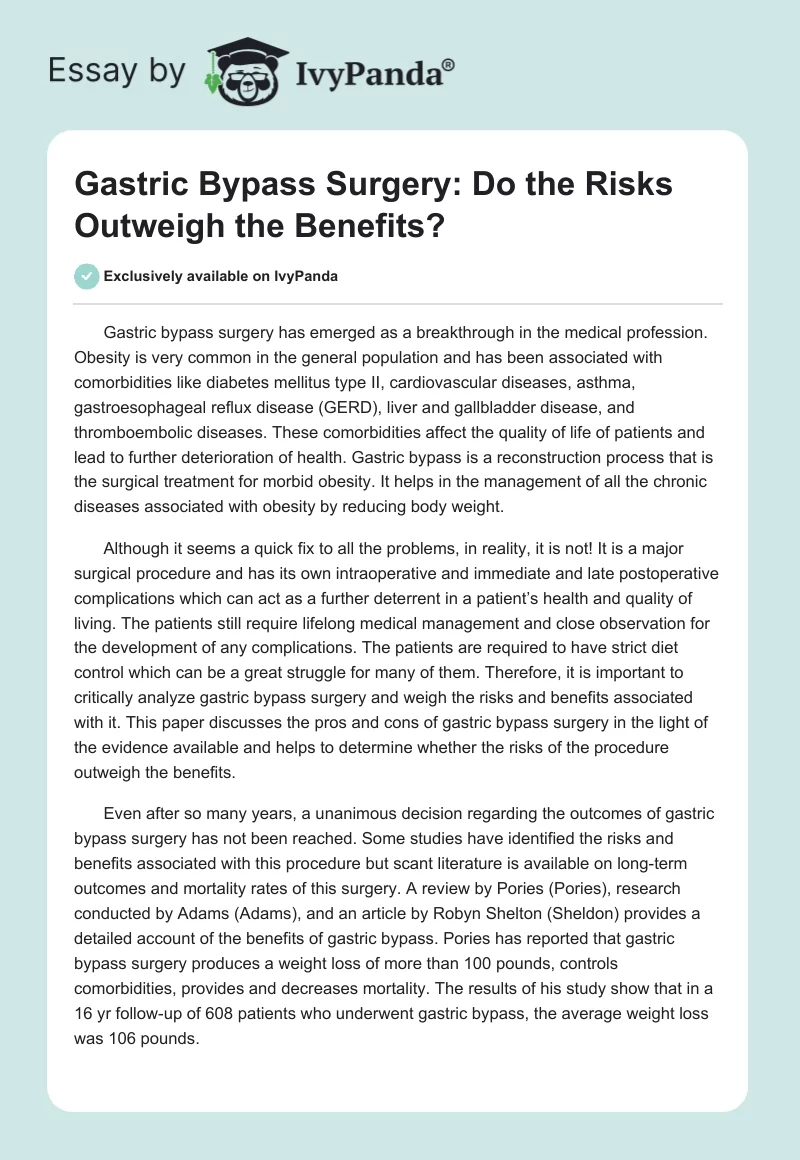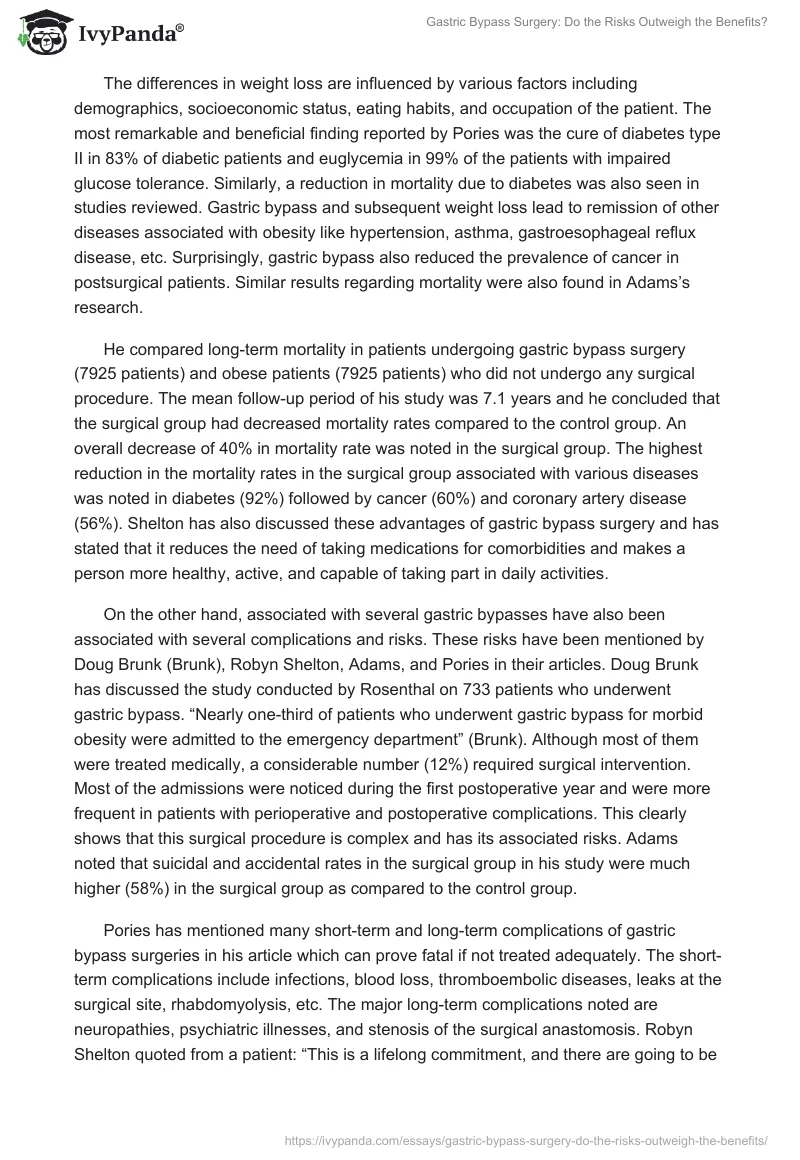Gastric bypass surgery has emerged as a breakthrough in the medical profession. Obesity is very common in the general population and has been associated with comorbidities like diabetes mellitus type II, cardiovascular diseases, asthma, gastroesophageal reflux disease (GERD), liver and gallbladder disease, and thromboembolic diseases. These comorbidities affect the quality of life of patients and lead to further deterioration of health. Gastric bypass is a reconstruction process that is the surgical treatment for morbid obesity. It helps in the management of all the chronic diseases associated with obesity by reducing body weight.
Although it seems a quick fix to all the problems, in reality, it is not! It is a major surgical procedure and has its own intraoperative and immediate and late postoperative complications which can act as a further deterrent in a patient’s health and quality of living. The patients still require lifelong medical management and close observation for the development of any complications. The patients are required to have strict diet control which can be a great struggle for many of them. Therefore, it is important to critically analyze gastric bypass surgery and weigh the risks and benefits associated with it. This paper discusses the pros and cons of gastric bypass surgery in the light of the evidence available and helps to determine whether the risks of the procedure outweigh the benefits.
Even after so many years, a unanimous decision regarding the outcomes of gastric bypass surgery has not been reached. Some studies have identified the risks and benefits associated with this procedure but scant literature is available on long-term outcomes and mortality rates of this surgery. A review by Pories (Pories), research conducted by Adams (Adams), and an article by Robyn Shelton (Sheldon) provides a detailed account of the benefits of gastric bypass. Pories has reported that gastric bypass surgery produces a weight loss of more than 100 pounds, controls comorbidities, provides and decreases mortality. The results of his study show that in a 16 yr follow-up of 608 patients who underwent gastric bypass, the average weight loss was 106 pounds.
The differences in weight loss are influenced by various factors including demographics, socioeconomic status, eating habits, and occupation of the patient. The most remarkable and beneficial finding reported by Pories was the cure of diabetes type II in 83% of diabetic patients and euglycemia in 99% of the patients with impaired glucose tolerance. Similarly, a reduction in mortality due to diabetes was also seen in studies reviewed. Gastric bypass and subsequent weight loss lead to remission of other diseases associated with obesity like hypertension, asthma, gastroesophageal reflux disease, etc. Surprisingly, gastric bypass also reduced the prevalence of cancer in postsurgical patients. Similar results regarding mortality were also found in Adams’s research.
He compared long-term mortality in patients undergoing gastric bypass surgery (7925 patients) and obese patients (7925 patients) who did not undergo any surgical procedure. The mean follow-up period of his study was 7.1 years and he concluded that the surgical group had decreased mortality rates compared to the control group. An overall decrease of 40% in mortality rate was noted in the surgical group. The highest reduction in the mortality rates in the surgical group associated with various diseases was noted in diabetes (92%) followed by cancer (60%) and coronary artery disease (56%). Shelton has also discussed these advantages of gastric bypass surgery and has stated that it reduces the need of taking medications for comorbidities and makes a person more healthy, active, and capable of taking part in daily activities.
On the other hand, associated with several gastric bypasses have also been associated with several complications and risks. These risks have been mentioned by Doug Brunk (Brunk), Robyn Shelton, Adams, and Pories in their articles. Doug Brunk has discussed the study conducted by Rosenthal on 733 patients who underwent gastric bypass. “Nearly one-third of patients who underwent gastric bypass for morbid obesity were admitted to the emergency department” (Brunk). Although most of them were treated medically, a considerable number (12%) required surgical intervention. Most of the admissions were noticed during the first postoperative year and were more frequent in patients with perioperative and postoperative complications. This clearly shows that this surgical procedure is complex and has its associated risks. Adams noted that suicidal and accidental rates in the surgical group in his study were much higher (58%) in the surgical group as compared to the control group.
Pories has mentioned many short-term and long-term complications of gastric bypass surgeries in his article which can prove fatal if not treated adequately. The short-term complications include infections, blood loss, thromboembolic diseases, leaks at the surgical site, rhabdomyolysis, etc. The major long-term complications noted are neuropathies, psychiatric illnesses, and stenosis of the surgical anastomosis. Robyn Shelton quoted from a patient: “This is a lifelong commitment, and there are going to be days when you’re sorry you’ve made this commitment” (Shelton). These are the words of a 26 years old patient who had internal bleeding after gastric bypass surgery and required another surgical operation. Robyn Shelton has described how patients can suffer terribly from complications after gastric bypass and regret their decision if they do not have adequate knowledge about the complications of the procedure before they undergo it. But at the same time, some patients are morbidly obese and require immediate surgical intervention for improvement in their health. In such cases, it is not wise to consider the complications associated with the procedure and delay the surgery.
Another major drawback of gastric bypass surgery is the potential for ‘addiction transfer. This phenomenon has been discussed by Souter (Souter) and Robyn Shelton. Souter has described the phenomenon of ‘addiction transfer’ as a process by which patients start abusing substances like alcohol, cigarettes, and money when they cannot abuse food after the surgery. Only a small proportion of patients (less than 5%) are affected by ‘addiction transfer’ but “it’s something people have to be aware of because it can get out of control” (Souter). In the article, Souter has described how three women developed addiction potential to different substances after gastric bypass.
They were addicted to food but could no longer abuse it so they adopted different ways of overcoming this addiction. The first example is of a 42 yrs old woman, Marcy. She became addicted to excessive shopping after the surgery. She bought loads of clothes and shoes even when she did not need them. This continued for many years and she spent all the money she had and ended up in a debt of $15,000. The second example is of a 29 yrs old woman, Katherine, who became addicted to alcohol after her surgery. Previously, she had never been an alcoholic in her life, but after surgery, she started drinking alcohol every weekend. She became addicted to such an extent that she drank uncountable glasses of alcohol at a time.
Due to this habit, she lost control of herself and was found unconscious in many places. She became very miserable and helpless but later on recovered from her addiction. She said: “Not a day passes that I don’t think about the damage I did to myself but I’m here to talk about it” (Souter). The third example is of a 54 yrs old woman, Annette, who became addicted to smoking cigarettes, as much as 5 cigarettes per day. All these examples quoted in the article highlight that ‘addiction transfer’ can make the lives of gastric bypass patients very miserable and they end up having complications due to the addictions, if not the disease and procedure itself. A similar concern has been shown by Robyn Shelton regarding this issue. It has been observed that patients think that surgery is an easy way out of the disease but they do not realize that there is great addiction potential associated with it.
In conclusion, there are many risks and benefits associated with gastric bypass surgery. This surgical procedure can lead to remission of diabetes, hypertension, obesity, asthma, GERD, etc., and also reduce the mortality rates associated with all these diseases. Patients are no longer required to take lifelong medications and can live healthier and more active life. But the patients require lifelong care and commitment. They have to be strong to deal with the complications associated with the procedure and might end up having a second surgery. Patients have to eat in moderate quantities and control their urge to eat excessively as this can lead to addiction transfer. I have seen my sister getting addicted to alcohol after gastric bypass and I know that this can make a person’s life even more miserable than it was before the procedure. Thus, patients should be carefully evaluated before the surgery to assess the need for surgery and to determine the risk for developing addiction transfer after surgery. Awareness should be created amongst patients regarding the complications of the surgical procedure and the quality of life after that.
References
Adams, Ted D. “Long-Term Mortality after Gastric Bypass Surgery. N Engl J Med (2007): 753-61. New England Journal of Medicine. Web.
Brunk, Doug. “One-third of Gastric Bypass Patients Visit ED.” Internal Medicine News (2007). Academic OneFile. Gale. Durham Technical Community Coll. Lib. Durham, NC. Web.
Pories, Walter J. “Bariatric Surgery: Risks and Rewards.” J Clin Endocrinol Metab (2008): S89–S96. Ovid SP. Web.
Sheldon, Robyn. “Despite Risks, Gastric-Bypass Surgeries Soar: Gastric-Bypass Procedures Can Be Effective — But Require a Lifelong Commitment.” Orlando Sentinel (2007). Newspaper Source Plus. EBSCO. Durham Technical Community Coll. Lib. Durham, NC. Web.
Souter, Ericka. “Trading One Addiction for Another.” People (2007). Middle Search Plus. EBSCO. Durham Technical Community Coll. Lib. Durham, NC. Web.


